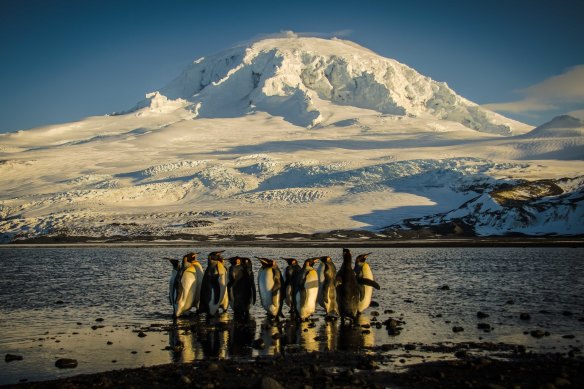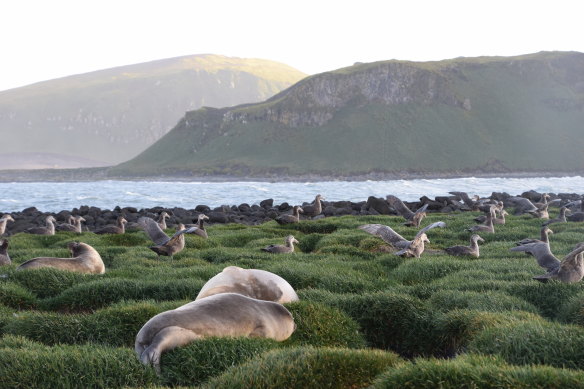Half Australia’s oceans to be protected in win for seals, penguins
By Mike Foley
Little-known Australian islands which teem with emperor penguins and elephant seals, and have the country’s only two active volcanoes, will be protected with an additional 300,000 square kilometres of marine park to be announced by the Albanese government on Tuesday.
The marine reserve around Heard Island and McDonald Islands in Australia’s Antarctic Territory will quadruple in size under the declaration to be made by Environment Minister Tanya Plibersek when she launches a global nature summit in Sydney.

Southern elephant seals chilling out in front of Heard Island’s volcano, Big Ben. Credit: Matt Curnock
The declaration means the proportion of the nation’s seas under conservation is now 52 per cent.
Conservation groups welcomed the marine park’s expansion as a significant environmental protection that would prohibit the expansion of fishing – which is only done by Australian vessels – in the sensitive environment and veto potential development of oil and gas extraction as well as undersea mining.
However, Pew Charitable Trusts, the Australian Marine Conservation Society and the World Wildlife Fund, along with 24 other groups, said the government “missed a rare opportunity” to protect high-value conservation areas for wildlife.
Heard Island and McDonald Islands are 4000 kilometres south-west of Perth and 1700 kilometres north of Antarctica, and each island has an active volcano.
Plibersek said the government had moved to protect the “truly pristine wilderness” with thriving populations of marine birds such as albatross, skuas (a type of seabird) as well as king, emperor and chinstrap penguins and seals such as the elephant, leopard and crabeater.
“I’m proud that Australia now protects more ocean than any other country on Earth,” said Plibersek.
“It is the biggest contribution to ocean conservation anywhere on the planet this year and follows our tripling of the protected waters around Macquarie Island last year.”
Commercial fishing is often targeted around Antarctic islands.
Several thousand tonnes of mackerel icefish and Patagonian toothfish are caught each year, which fetches a high value at top restaurants.
The government said the fishery is well-managed and sustainable, but experts are concerned that fish are being harvested in prime locations.
The Albanese government last year announced a near-tripling of the marine park around Macquarie Island, and was praised by conservation groups for restricting the area that can be fished. An independent scientific review, commissioned by the government, urged them do the same with Heard Island and McDonald Islands.

A parade of king penguins at Corinthian Bay, Heard Island and McDonald Islands.Credit: Matt Curnock
WWF Australia oceans campaigner Richard Leck said fishing should have been barred from a larger portion of critical habitats, which are important feeding grounds for penguins, seals and other marine life.
“WWF Australia welcomes the Australian government’s significant expansion of the marine park, but unfortunately the final plan announced today is a missed opportunity to secure protection for some of the islands’ highest priority conservation areas,” Leck said.
Pew Charitable Trusts national oceans manager Fiona Maxwell said the marine park design would be concerning for scientists, who had called for more fishing restrictions.

Southern elephant seals and southern giant petrels. Credit: Fred Belton.
“The government’s decision to leave important undersea canyons, highly biodiverse seamounts and the Williams Ridge outside of sanctuaries will disappoint the tens of thousands of Australians, including leading scientists, who made submissions calling for stronger protection of these critical habitats,” Maxwell said.
Plibersek timed the announcement of the expanded marine park for the first day of the Global Nature Positive Summit, which starts in Sydney on Tuesday. The event will serve, in part, as a showcase for the government’s nature-positive agenda, with the creation of new laws aimed at opening a nature-repair market.
The scheme, which begins in January, was designed to attract funds from the private sector, with Plibersek arguing the public purse alone is too small to fund the repairs needed for Australia’s beleaguered natural assets.
Under the new scheme, biodiversity certificates can be earned by private landholders such as farmers for repairing degraded areas including wetlands, riverbanks, wildlife corridors between forests, and areas with rare vegetation.
The certificates can be bought by companies looking to offset environmental impacts or boost their public image, or by philanthropists. Estimates of potential earnings range up to $2000 per hectare, depending on market prices.
Cut through the noise of federal politics with news, views and expert analysis. Subscribers can sign up to our weekly Inside Politics newsletter.